Case Study: Safeguarding Plan for Protection of Vulnerable Persons
VerifiedAdded on 2022/08/24
|10
|2665
|29
Case Study
AI Summary
This case study presents a comprehensive safeguarding plan designed to protect vulnerable individuals, including Leo with Down's syndrome, Mrs. B who suffered a fall, and Susi, a woman with a mild learning disability. The plan addresses the identification of primary issues, outlining risks associated with each individual's circumstances, such as Leo's potential involvement in illegal activities, Mrs. B's reduced mobility, and Susi's vulnerability to online exploitation. The plan details roles and responsibilities, emphasizing the local authority's role in coordination and the need for a lead professional. It includes assessment of abuse or neglect, highlighting the importance of understanding mental capacity and fall risk factors. The safeguarding protocols for each individual include restrictions, referrals to support services, and home modifications. The plan emphasizes the principles of empowerment, prevention, and partnership, ensuring confidentiality and the involvement of the individuals in decision-making processes. The plan also outlines the importance of vocational training and mental health assessments, aiming to promote their independence and well-being, and ensuring their safety and protection from harm.
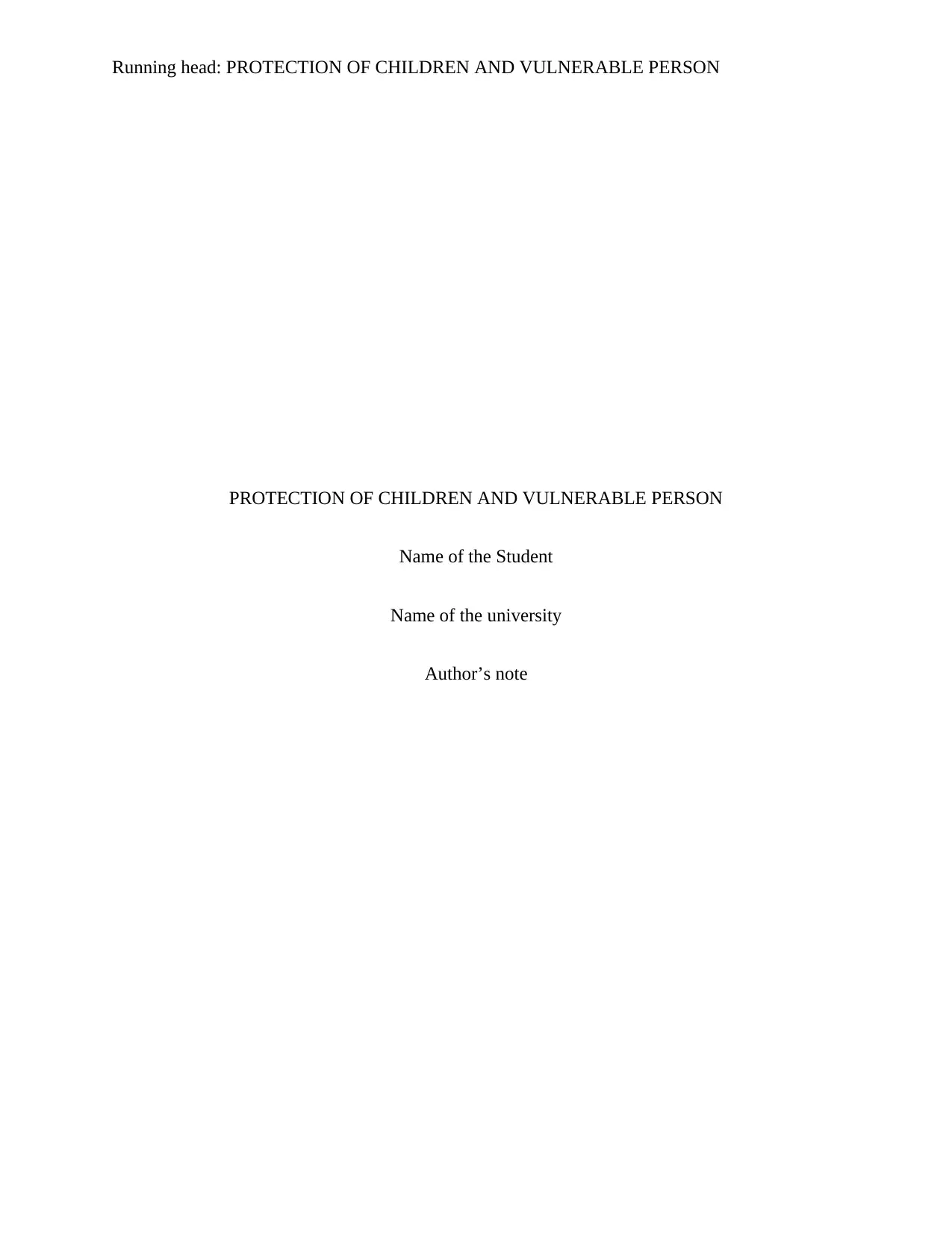
Running head: PROTECTION OF CHILDREN AND VULNERABLE PERSON
PROTECTION OF CHILDREN AND VULNERABLE PERSON
Name of the Student
Name of the university
Author’s note
PROTECTION OF CHILDREN AND VULNERABLE PERSON
Name of the Student
Name of the university
Author’s note
Paraphrase This Document
Need a fresh take? Get an instant paraphrase of this document with our AI Paraphraser

1PROTECTION OF CHILDREN AND VULNERABLE PERSON
Safe guarding plan
Purpose
The purpose of this safe guarding plan is to formalise and coordinate a range of actions
for protecting the vulnerable group (In this case, Leo with Down’s syndrome, Mrs. B , who had
suffered from a fall, and Susi, a widowed and a divorced women with mild learning disability).
The main aim would be to assure their safety in the future, provision of any support, therapy and
treatment including an on-going advocacy, any alterations that can be required, any ongoing risk
management strategy as appropriate.
Identification of the primary issues
For Leo
The primary issue that is present in this case is that, Leo had been living in a supported living
tenant had made friends with some people at the bar and had been delivering parcels for them,
without having any knowledge of the contents of the parcel. This can be risky for Leo, as the
packages might contain illegitimate stuffs, which can bring Leo under direct lawsuits with the
allegation of delivering illegal stuffs.
For Mrs. B
Mrs. B had suffered from a fall, that has caused a marked reduction in the mobility of the Mrs. B.
As per the physiotherapists and Mrs. B’s family, she needs to be moved to a nursing home to
receive the best care possible or else she needs a rigorous home support with a care package
from the support workers as Mrs. B does not want to go to a nursing home and Mrs. B’s daughter
Safe guarding plan
Purpose
The purpose of this safe guarding plan is to formalise and coordinate a range of actions
for protecting the vulnerable group (In this case, Leo with Down’s syndrome, Mrs. B , who had
suffered from a fall, and Susi, a widowed and a divorced women with mild learning disability).
The main aim would be to assure their safety in the future, provision of any support, therapy and
treatment including an on-going advocacy, any alterations that can be required, any ongoing risk
management strategy as appropriate.
Identification of the primary issues
For Leo
The primary issue that is present in this case is that, Leo had been living in a supported living
tenant had made friends with some people at the bar and had been delivering parcels for them,
without having any knowledge of the contents of the parcel. This can be risky for Leo, as the
packages might contain illegitimate stuffs, which can bring Leo under direct lawsuits with the
allegation of delivering illegal stuffs.
For Mrs. B
Mrs. B had suffered from a fall, that has caused a marked reduction in the mobility of the Mrs. B.
As per the physiotherapists and Mrs. B’s family, she needs to be moved to a nursing home to
receive the best care possible or else she needs a rigorous home support with a care package
from the support workers as Mrs. B does not want to go to a nursing home and Mrs. B’s daughter
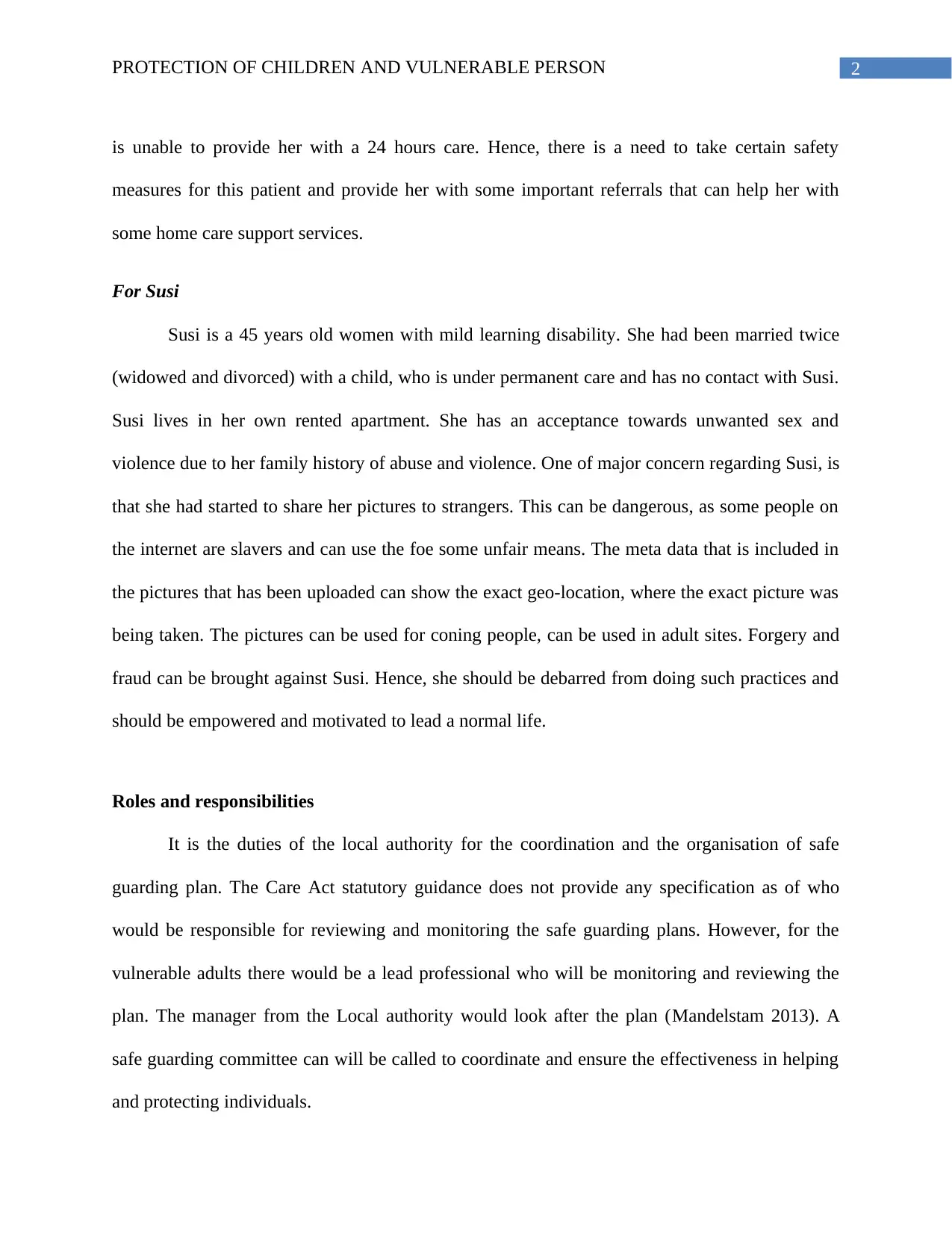
2PROTECTION OF CHILDREN AND VULNERABLE PERSON
is unable to provide her with a 24 hours care. Hence, there is a need to take certain safety
measures for this patient and provide her with some important referrals that can help her with
some home care support services.
For Susi
Susi is a 45 years old women with mild learning disability. She had been married twice
(widowed and divorced) with a child, who is under permanent care and has no contact with Susi.
Susi lives in her own rented apartment. She has an acceptance towards unwanted sex and
violence due to her family history of abuse and violence. One of major concern regarding Susi, is
that she had started to share her pictures to strangers. This can be dangerous, as some people on
the internet are slavers and can use the foe some unfair means. The meta data that is included in
the pictures that has been uploaded can show the exact geo-location, where the exact picture was
being taken. The pictures can be used for coning people, can be used in adult sites. Forgery and
fraud can be brought against Susi. Hence, she should be debarred from doing such practices and
should be empowered and motivated to lead a normal life.
Roles and responsibilities
It is the duties of the local authority for the coordination and the organisation of safe
guarding plan. The Care Act statutory guidance does not provide any specification as of who
would be responsible for reviewing and monitoring the safe guarding plans. However, for the
vulnerable adults there would be a lead professional who will be monitoring and reviewing the
plan. The manager from the Local authority would look after the plan (Mandelstam 2013). A
safe guarding committee can will be called to coordinate and ensure the effectiveness in helping
and protecting individuals.
is unable to provide her with a 24 hours care. Hence, there is a need to take certain safety
measures for this patient and provide her with some important referrals that can help her with
some home care support services.
For Susi
Susi is a 45 years old women with mild learning disability. She had been married twice
(widowed and divorced) with a child, who is under permanent care and has no contact with Susi.
Susi lives in her own rented apartment. She has an acceptance towards unwanted sex and
violence due to her family history of abuse and violence. One of major concern regarding Susi, is
that she had started to share her pictures to strangers. This can be dangerous, as some people on
the internet are slavers and can use the foe some unfair means. The meta data that is included in
the pictures that has been uploaded can show the exact geo-location, where the exact picture was
being taken. The pictures can be used for coning people, can be used in adult sites. Forgery and
fraud can be brought against Susi. Hence, she should be debarred from doing such practices and
should be empowered and motivated to lead a normal life.
Roles and responsibilities
It is the duties of the local authority for the coordination and the organisation of safe
guarding plan. The Care Act statutory guidance does not provide any specification as of who
would be responsible for reviewing and monitoring the safe guarding plans. However, for the
vulnerable adults there would be a lead professional who will be monitoring and reviewing the
plan. The manager from the Local authority would look after the plan (Mandelstam 2013). A
safe guarding committee can will be called to coordinate and ensure the effectiveness in helping
and protecting individuals.
⊘ This is a preview!⊘
Do you want full access?
Subscribe today to unlock all pages.

Trusted by 1+ million students worldwide
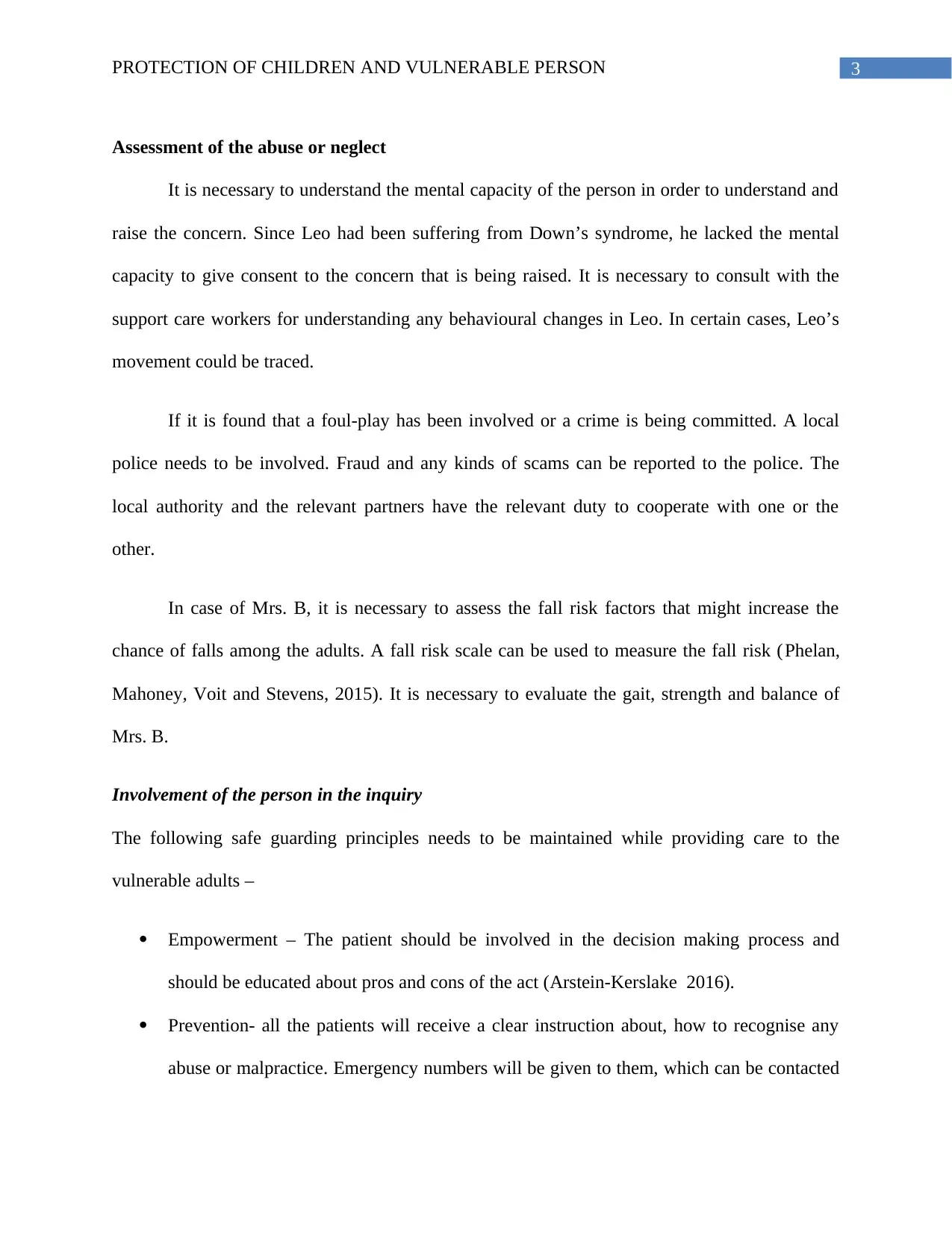
3PROTECTION OF CHILDREN AND VULNERABLE PERSON
Assessment of the abuse or neglect
It is necessary to understand the mental capacity of the person in order to understand and
raise the concern. Since Leo had been suffering from Down’s syndrome, he lacked the mental
capacity to give consent to the concern that is being raised. It is necessary to consult with the
support care workers for understanding any behavioural changes in Leo. In certain cases, Leo’s
movement could be traced.
If it is found that a foul-play has been involved or a crime is being committed. A local
police needs to be involved. Fraud and any kinds of scams can be reported to the police. The
local authority and the relevant partners have the relevant duty to cooperate with one or the
other.
In case of Mrs. B, it is necessary to assess the fall risk factors that might increase the
chance of falls among the adults. A fall risk scale can be used to measure the fall risk (Phelan,
Mahoney, Voit and Stevens, 2015). It is necessary to evaluate the gait, strength and balance of
Mrs. B.
Involvement of the person in the inquiry
The following safe guarding principles needs to be maintained while providing care to the
vulnerable adults –
Empowerment – The patient should be involved in the decision making process and
should be educated about pros and cons of the act (Arstein-Kerslake 2016).
Prevention- all the patients will receive a clear instruction about, how to recognise any
abuse or malpractice. Emergency numbers will be given to them, which can be contacted
Assessment of the abuse or neglect
It is necessary to understand the mental capacity of the person in order to understand and
raise the concern. Since Leo had been suffering from Down’s syndrome, he lacked the mental
capacity to give consent to the concern that is being raised. It is necessary to consult with the
support care workers for understanding any behavioural changes in Leo. In certain cases, Leo’s
movement could be traced.
If it is found that a foul-play has been involved or a crime is being committed. A local
police needs to be involved. Fraud and any kinds of scams can be reported to the police. The
local authority and the relevant partners have the relevant duty to cooperate with one or the
other.
In case of Mrs. B, it is necessary to assess the fall risk factors that might increase the
chance of falls among the adults. A fall risk scale can be used to measure the fall risk (Phelan,
Mahoney, Voit and Stevens, 2015). It is necessary to evaluate the gait, strength and balance of
Mrs. B.
Involvement of the person in the inquiry
The following safe guarding principles needs to be maintained while providing care to the
vulnerable adults –
Empowerment – The patient should be involved in the decision making process and
should be educated about pros and cons of the act (Arstein-Kerslake 2016).
Prevention- all the patients will receive a clear instruction about, how to recognise any
abuse or malpractice. Emergency numbers will be given to them, which can be contacted
Paraphrase This Document
Need a fresh take? Get an instant paraphrase of this document with our AI Paraphraser
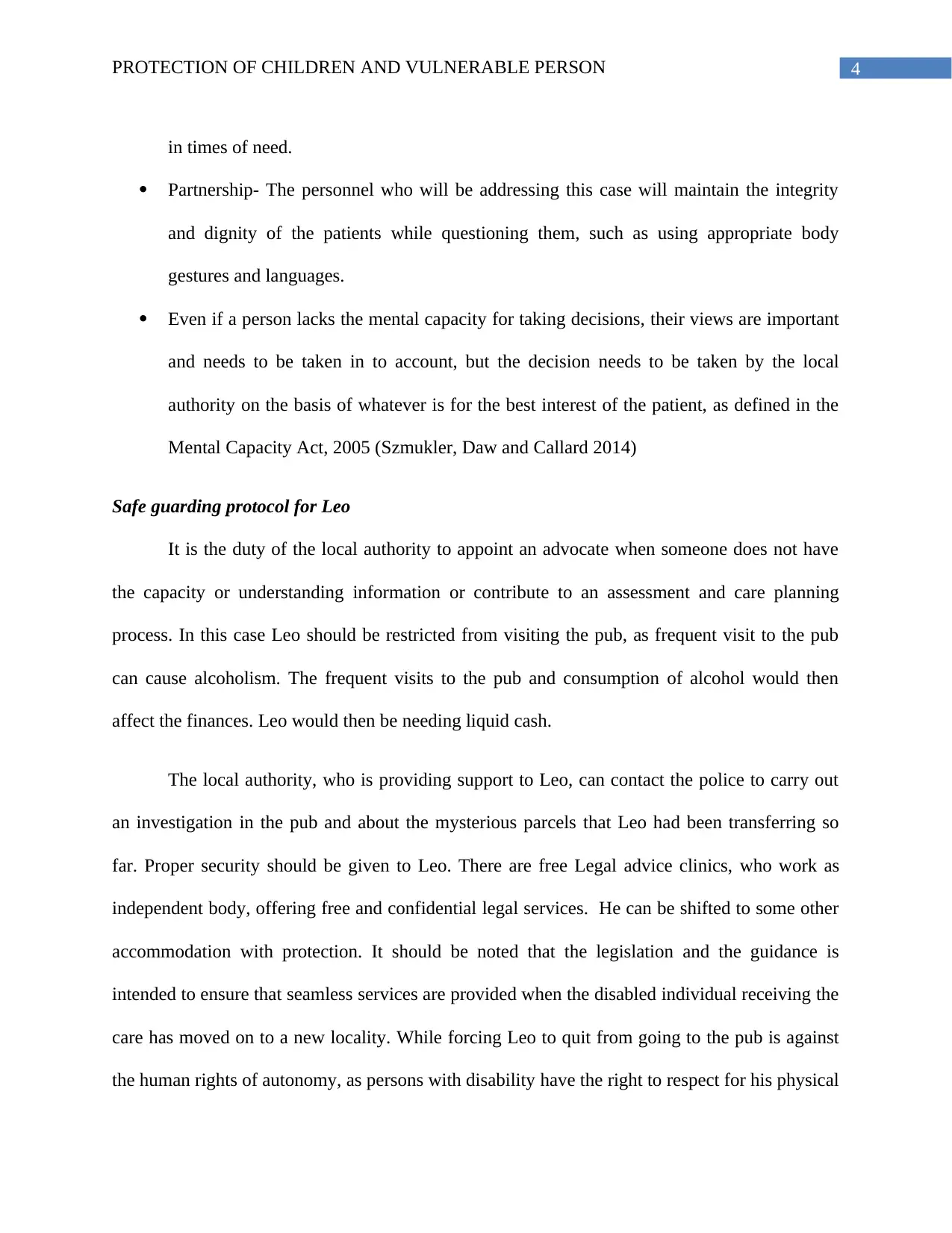
4PROTECTION OF CHILDREN AND VULNERABLE PERSON
in times of need.
Partnership- The personnel who will be addressing this case will maintain the integrity
and dignity of the patients while questioning them, such as using appropriate body
gestures and languages.
Even if a person lacks the mental capacity for taking decisions, their views are important
and needs to be taken in to account, but the decision needs to be taken by the local
authority on the basis of whatever is for the best interest of the patient, as defined in the
Mental Capacity Act, 2005 (Szmukler, Daw and Callard 2014)
Safe guarding protocol for Leo
It is the duty of the local authority to appoint an advocate when someone does not have
the capacity or understanding information or contribute to an assessment and care planning
process. In this case Leo should be restricted from visiting the pub, as frequent visit to the pub
can cause alcoholism. The frequent visits to the pub and consumption of alcohol would then
affect the finances. Leo would then be needing liquid cash.
The local authority, who is providing support to Leo, can contact the police to carry out
an investigation in the pub and about the mysterious parcels that Leo had been transferring so
far. Proper security should be given to Leo. There are free Legal advice clinics, who work as
independent body, offering free and confidential legal services. He can be shifted to some other
accommodation with protection. It should be noted that the legislation and the guidance is
intended to ensure that seamless services are provided when the disabled individual receiving the
care has moved on to a new locality. While forcing Leo to quit from going to the pub is against
the human rights of autonomy, as persons with disability have the right to respect for his physical
in times of need.
Partnership- The personnel who will be addressing this case will maintain the integrity
and dignity of the patients while questioning them, such as using appropriate body
gestures and languages.
Even if a person lacks the mental capacity for taking decisions, their views are important
and needs to be taken in to account, but the decision needs to be taken by the local
authority on the basis of whatever is for the best interest of the patient, as defined in the
Mental Capacity Act, 2005 (Szmukler, Daw and Callard 2014)
Safe guarding protocol for Leo
It is the duty of the local authority to appoint an advocate when someone does not have
the capacity or understanding information or contribute to an assessment and care planning
process. In this case Leo should be restricted from visiting the pub, as frequent visit to the pub
can cause alcoholism. The frequent visits to the pub and consumption of alcohol would then
affect the finances. Leo would then be needing liquid cash.
The local authority, who is providing support to Leo, can contact the police to carry out
an investigation in the pub and about the mysterious parcels that Leo had been transferring so
far. Proper security should be given to Leo. There are free Legal advice clinics, who work as
independent body, offering free and confidential legal services. He can be shifted to some other
accommodation with protection. It should be noted that the legislation and the guidance is
intended to ensure that seamless services are provided when the disabled individual receiving the
care has moved on to a new locality. While forcing Leo to quit from going to the pub is against
the human rights of autonomy, as persons with disability have the right to respect for his physical
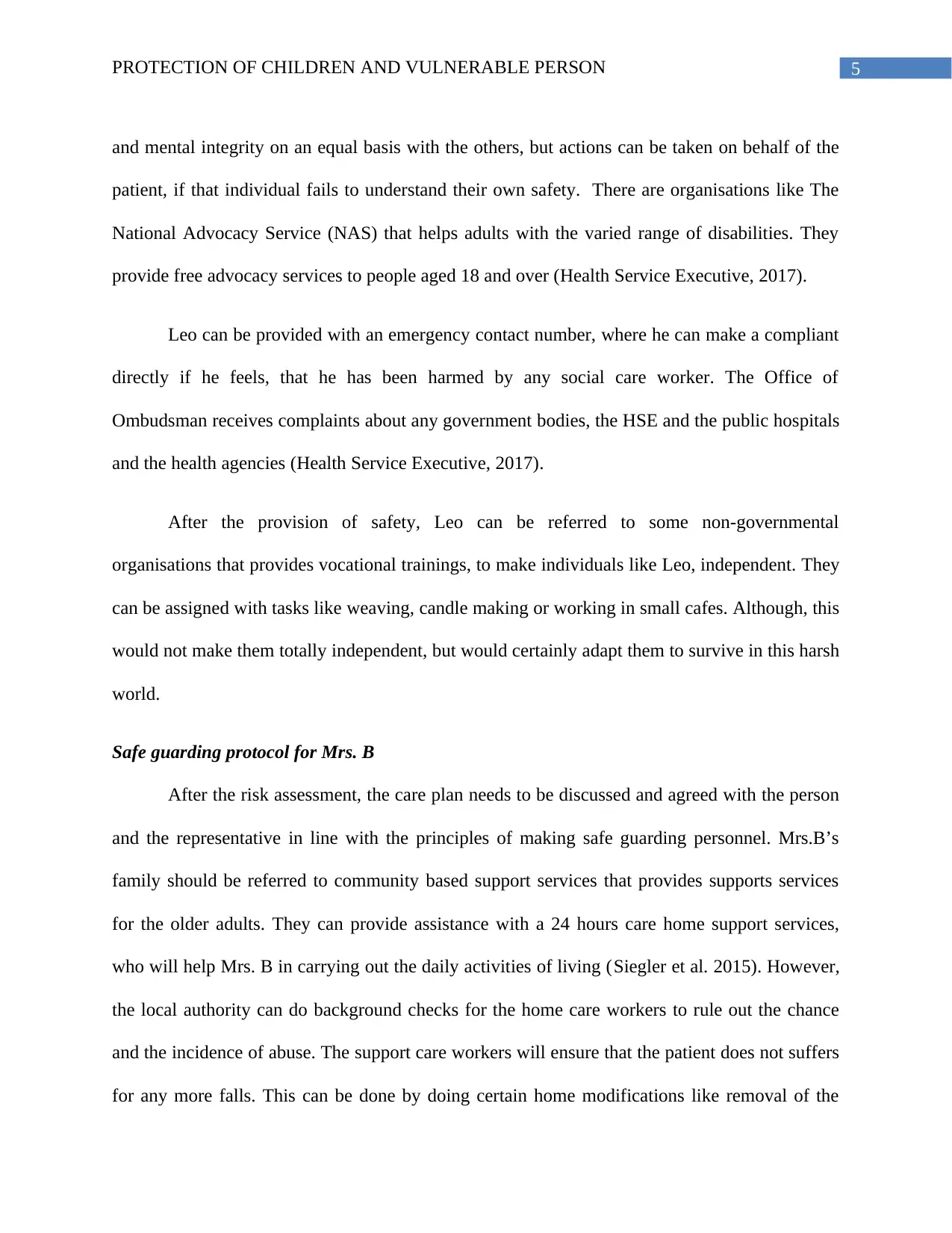
5PROTECTION OF CHILDREN AND VULNERABLE PERSON
and mental integrity on an equal basis with the others, but actions can be taken on behalf of the
patient, if that individual fails to understand their own safety. There are organisations like The
National Advocacy Service (NAS) that helps adults with the varied range of disabilities. They
provide free advocacy services to people aged 18 and over (Health Service Executive, 2017).
Leo can be provided with an emergency contact number, where he can make a compliant
directly if he feels, that he has been harmed by any social care worker. The Office of
Ombudsman receives complaints about any government bodies, the HSE and the public hospitals
and the health agencies (Health Service Executive, 2017).
After the provision of safety, Leo can be referred to some non-governmental
organisations that provides vocational trainings, to make individuals like Leo, independent. They
can be assigned with tasks like weaving, candle making or working in small cafes. Although, this
would not make them totally independent, but would certainly adapt them to survive in this harsh
world.
Safe guarding protocol for Mrs. B
After the risk assessment, the care plan needs to be discussed and agreed with the person
and the representative in line with the principles of making safe guarding personnel. Mrs.B’s
family should be referred to community based support services that provides supports services
for the older adults. They can provide assistance with a 24 hours care home support services,
who will help Mrs. B in carrying out the daily activities of living (Siegler et al. 2015). However,
the local authority can do background checks for the home care workers to rule out the chance
and the incidence of abuse. The support care workers will ensure that the patient does not suffers
for any more falls. This can be done by doing certain home modifications like removal of the
and mental integrity on an equal basis with the others, but actions can be taken on behalf of the
patient, if that individual fails to understand their own safety. There are organisations like The
National Advocacy Service (NAS) that helps adults with the varied range of disabilities. They
provide free advocacy services to people aged 18 and over (Health Service Executive, 2017).
Leo can be provided with an emergency contact number, where he can make a compliant
directly if he feels, that he has been harmed by any social care worker. The Office of
Ombudsman receives complaints about any government bodies, the HSE and the public hospitals
and the health agencies (Health Service Executive, 2017).
After the provision of safety, Leo can be referred to some non-governmental
organisations that provides vocational trainings, to make individuals like Leo, independent. They
can be assigned with tasks like weaving, candle making or working in small cafes. Although, this
would not make them totally independent, but would certainly adapt them to survive in this harsh
world.
Safe guarding protocol for Mrs. B
After the risk assessment, the care plan needs to be discussed and agreed with the person
and the representative in line with the principles of making safe guarding personnel. Mrs.B’s
family should be referred to community based support services that provides supports services
for the older adults. They can provide assistance with a 24 hours care home support services,
who will help Mrs. B in carrying out the daily activities of living (Siegler et al. 2015). However,
the local authority can do background checks for the home care workers to rule out the chance
and the incidence of abuse. The support care workers will ensure that the patient does not suffers
for any more falls. This can be done by doing certain home modifications like removal of the
⊘ This is a preview!⊘
Do you want full access?
Subscribe today to unlock all pages.

Trusted by 1+ million students worldwide
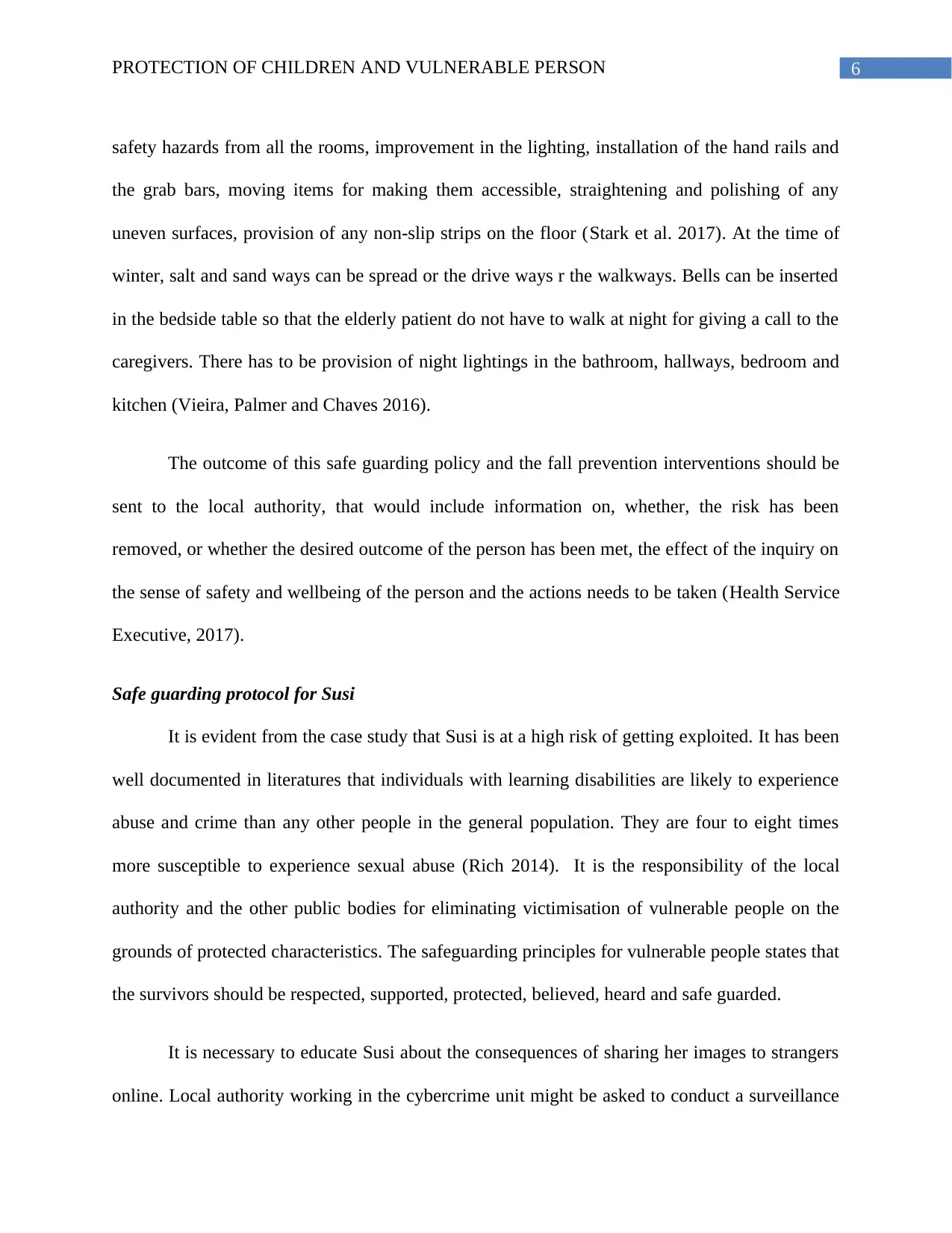
6PROTECTION OF CHILDREN AND VULNERABLE PERSON
safety hazards from all the rooms, improvement in the lighting, installation of the hand rails and
the grab bars, moving items for making them accessible, straightening and polishing of any
uneven surfaces, provision of any non-slip strips on the floor (Stark et al. 2017). At the time of
winter, salt and sand ways can be spread or the drive ways r the walkways. Bells can be inserted
in the bedside table so that the elderly patient do not have to walk at night for giving a call to the
caregivers. There has to be provision of night lightings in the bathroom, hallways, bedroom and
kitchen (Vieira, Palmer and Chaves 2016).
The outcome of this safe guarding policy and the fall prevention interventions should be
sent to the local authority, that would include information on, whether, the risk has been
removed, or whether the desired outcome of the person has been met, the effect of the inquiry on
the sense of safety and wellbeing of the person and the actions needs to be taken (Health Service
Executive, 2017).
Safe guarding protocol for Susi
It is evident from the case study that Susi is at a high risk of getting exploited. It has been
well documented in literatures that individuals with learning disabilities are likely to experience
abuse and crime than any other people in the general population. They are four to eight times
more susceptible to experience sexual abuse (Rich 2014). It is the responsibility of the local
authority and the other public bodies for eliminating victimisation of vulnerable people on the
grounds of protected characteristics. The safeguarding principles for vulnerable people states that
the survivors should be respected, supported, protected, believed, heard and safe guarded.
It is necessary to educate Susi about the consequences of sharing her images to strangers
online. Local authority working in the cybercrime unit might be asked to conduct a surveillance
safety hazards from all the rooms, improvement in the lighting, installation of the hand rails and
the grab bars, moving items for making them accessible, straightening and polishing of any
uneven surfaces, provision of any non-slip strips on the floor (Stark et al. 2017). At the time of
winter, salt and sand ways can be spread or the drive ways r the walkways. Bells can be inserted
in the bedside table so that the elderly patient do not have to walk at night for giving a call to the
caregivers. There has to be provision of night lightings in the bathroom, hallways, bedroom and
kitchen (Vieira, Palmer and Chaves 2016).
The outcome of this safe guarding policy and the fall prevention interventions should be
sent to the local authority, that would include information on, whether, the risk has been
removed, or whether the desired outcome of the person has been met, the effect of the inquiry on
the sense of safety and wellbeing of the person and the actions needs to be taken (Health Service
Executive, 2017).
Safe guarding protocol for Susi
It is evident from the case study that Susi is at a high risk of getting exploited. It has been
well documented in literatures that individuals with learning disabilities are likely to experience
abuse and crime than any other people in the general population. They are four to eight times
more susceptible to experience sexual abuse (Rich 2014). It is the responsibility of the local
authority and the other public bodies for eliminating victimisation of vulnerable people on the
grounds of protected characteristics. The safeguarding principles for vulnerable people states that
the survivors should be respected, supported, protected, believed, heard and safe guarded.
It is necessary to educate Susi about the consequences of sharing her images to strangers
online. Local authority working in the cybercrime unit might be asked to conduct a surveillance
Paraphrase This Document
Need a fresh take? Get an instant paraphrase of this document with our AI Paraphraser
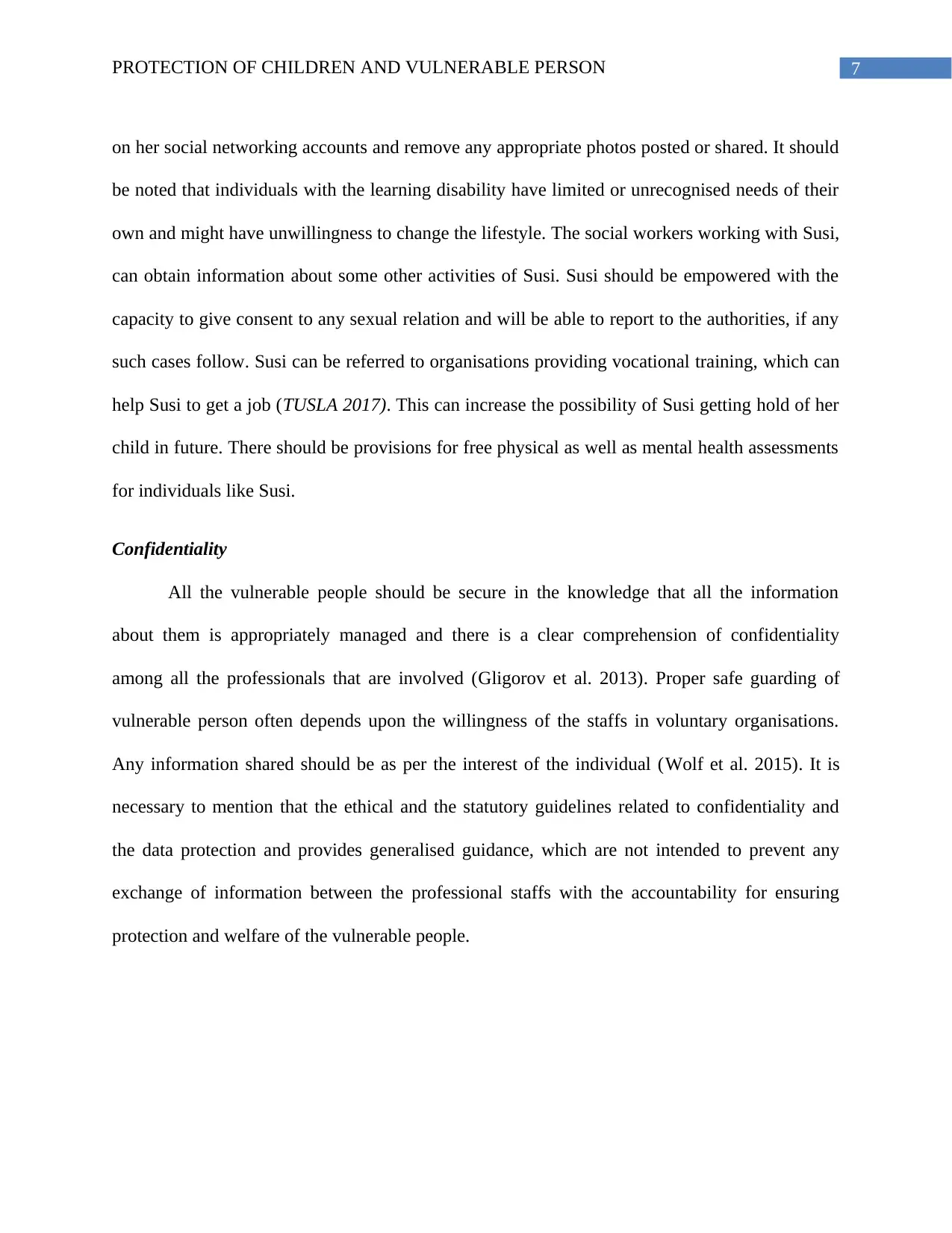
7PROTECTION OF CHILDREN AND VULNERABLE PERSON
on her social networking accounts and remove any appropriate photos posted or shared. It should
be noted that individuals with the learning disability have limited or unrecognised needs of their
own and might have unwillingness to change the lifestyle. The social workers working with Susi,
can obtain information about some other activities of Susi. Susi should be empowered with the
capacity to give consent to any sexual relation and will be able to report to the authorities, if any
such cases follow. Susi can be referred to organisations providing vocational training, which can
help Susi to get a job (TUSLA 2017). This can increase the possibility of Susi getting hold of her
child in future. There should be provisions for free physical as well as mental health assessments
for individuals like Susi.
Confidentiality
All the vulnerable people should be secure in the knowledge that all the information
about them is appropriately managed and there is a clear comprehension of confidentiality
among all the professionals that are involved (Gligorov et al. 2013). Proper safe guarding of
vulnerable person often depends upon the willingness of the staffs in voluntary organisations.
Any information shared should be as per the interest of the individual (Wolf et al. 2015). It is
necessary to mention that the ethical and the statutory guidelines related to confidentiality and
the data protection and provides generalised guidance, which are not intended to prevent any
exchange of information between the professional staffs with the accountability for ensuring
protection and welfare of the vulnerable people.
on her social networking accounts and remove any appropriate photos posted or shared. It should
be noted that individuals with the learning disability have limited or unrecognised needs of their
own and might have unwillingness to change the lifestyle. The social workers working with Susi,
can obtain information about some other activities of Susi. Susi should be empowered with the
capacity to give consent to any sexual relation and will be able to report to the authorities, if any
such cases follow. Susi can be referred to organisations providing vocational training, which can
help Susi to get a job (TUSLA 2017). This can increase the possibility of Susi getting hold of her
child in future. There should be provisions for free physical as well as mental health assessments
for individuals like Susi.
Confidentiality
All the vulnerable people should be secure in the knowledge that all the information
about them is appropriately managed and there is a clear comprehension of confidentiality
among all the professionals that are involved (Gligorov et al. 2013). Proper safe guarding of
vulnerable person often depends upon the willingness of the staffs in voluntary organisations.
Any information shared should be as per the interest of the individual (Wolf et al. 2015). It is
necessary to mention that the ethical and the statutory guidelines related to confidentiality and
the data protection and provides generalised guidance, which are not intended to prevent any
exchange of information between the professional staffs with the accountability for ensuring
protection and welfare of the vulnerable people.
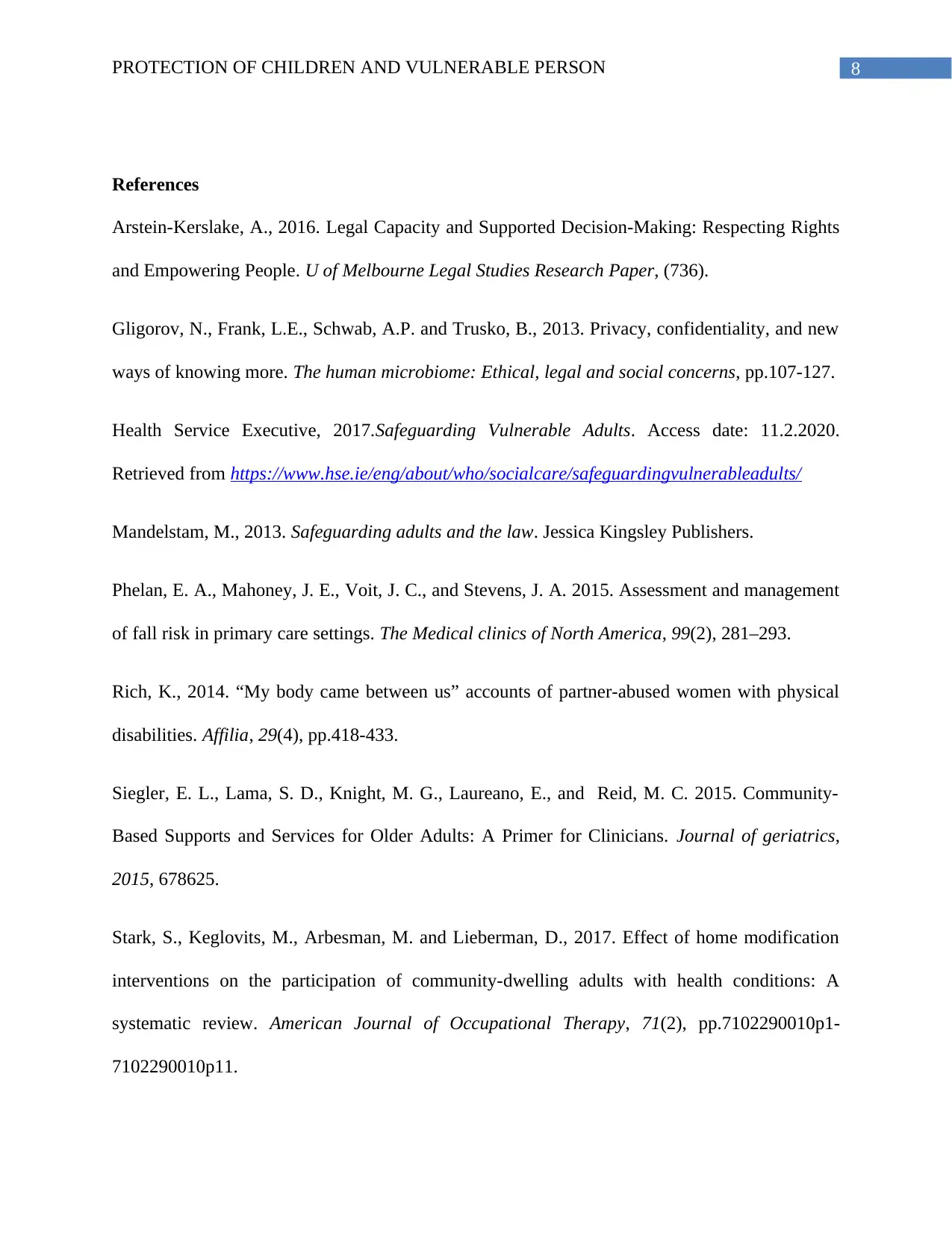
8PROTECTION OF CHILDREN AND VULNERABLE PERSON
References
Arstein-Kerslake, A., 2016. Legal Capacity and Supported Decision-Making: Respecting Rights
and Empowering People. U of Melbourne Legal Studies Research Paper, (736).
Gligorov, N., Frank, L.E., Schwab, A.P. and Trusko, B., 2013. Privacy, confidentiality, and new
ways of knowing more. The human microbiome: Ethical, legal and social concerns, pp.107-127.
Health Service Executive, 2017.Safeguarding Vulnerable Adults. Access date: 11.2.2020.
Retrieved from https://www.hse.ie/eng/about/who/socialcare/safeguardingvulnerableadults/
Mandelstam, M., 2013. Safeguarding adults and the law. Jessica Kingsley Publishers.
Phelan, E. A., Mahoney, J. E., Voit, J. C., and Stevens, J. A. 2015. Assessment and management
of fall risk in primary care settings. The Medical clinics of North America, 99(2), 281–293.
Rich, K., 2014. “My body came between us” accounts of partner-abused women with physical
disabilities. Affilia, 29(4), pp.418-433.
Siegler, E. L., Lama, S. D., Knight, M. G., Laureano, E., and Reid, M. C. 2015. Community-
Based Supports and Services for Older Adults: A Primer for Clinicians. Journal of geriatrics,
2015, 678625.
Stark, S., Keglovits, M., Arbesman, M. and Lieberman, D., 2017. Effect of home modification
interventions on the participation of community-dwelling adults with health conditions: A
systematic review. American Journal of Occupational Therapy, 71(2), pp.7102290010p1-
7102290010p11.
References
Arstein-Kerslake, A., 2016. Legal Capacity and Supported Decision-Making: Respecting Rights
and Empowering People. U of Melbourne Legal Studies Research Paper, (736).
Gligorov, N., Frank, L.E., Schwab, A.P. and Trusko, B., 2013. Privacy, confidentiality, and new
ways of knowing more. The human microbiome: Ethical, legal and social concerns, pp.107-127.
Health Service Executive, 2017.Safeguarding Vulnerable Adults. Access date: 11.2.2020.
Retrieved from https://www.hse.ie/eng/about/who/socialcare/safeguardingvulnerableadults/
Mandelstam, M., 2013. Safeguarding adults and the law. Jessica Kingsley Publishers.
Phelan, E. A., Mahoney, J. E., Voit, J. C., and Stevens, J. A. 2015. Assessment and management
of fall risk in primary care settings. The Medical clinics of North America, 99(2), 281–293.
Rich, K., 2014. “My body came between us” accounts of partner-abused women with physical
disabilities. Affilia, 29(4), pp.418-433.
Siegler, E. L., Lama, S. D., Knight, M. G., Laureano, E., and Reid, M. C. 2015. Community-
Based Supports and Services for Older Adults: A Primer for Clinicians. Journal of geriatrics,
2015, 678625.
Stark, S., Keglovits, M., Arbesman, M. and Lieberman, D., 2017. Effect of home modification
interventions on the participation of community-dwelling adults with health conditions: A
systematic review. American Journal of Occupational Therapy, 71(2), pp.7102290010p1-
7102290010p11.
⊘ This is a preview!⊘
Do you want full access?
Subscribe today to unlock all pages.

Trusted by 1+ million students worldwide
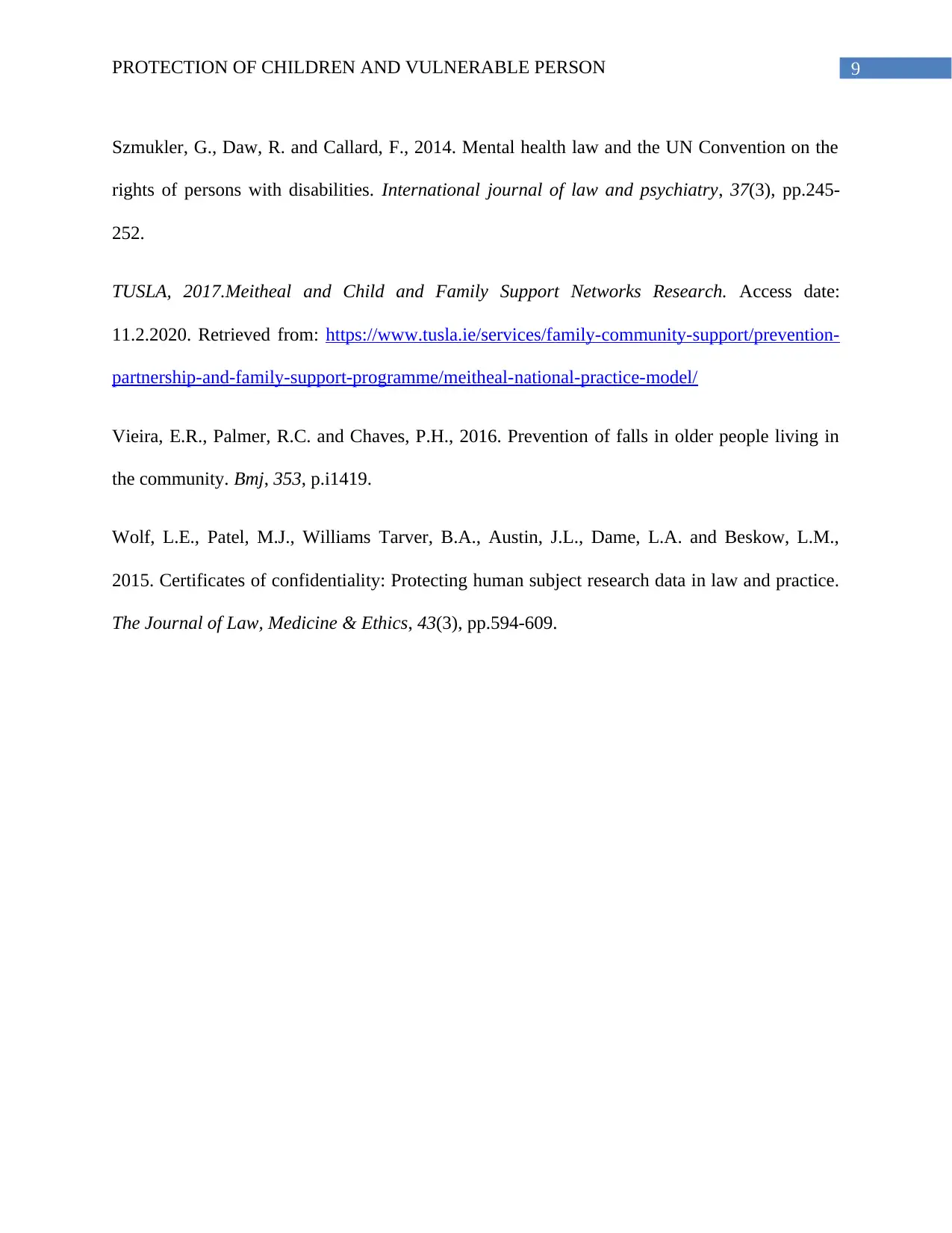
9PROTECTION OF CHILDREN AND VULNERABLE PERSON
Szmukler, G., Daw, R. and Callard, F., 2014. Mental health law and the UN Convention on the
rights of persons with disabilities. International journal of law and psychiatry, 37(3), pp.245-
252.
TUSLA, 2017.Meitheal and Child and Family Support Networks Research. Access date:
11.2.2020. Retrieved from: https://www.tusla.ie/services/family-community-support/prevention-
partnership-and-family-support-programme/meitheal-national-practice-model/
Vieira, E.R., Palmer, R.C. and Chaves, P.H., 2016. Prevention of falls in older people living in
the community. Bmj, 353, p.i1419.
Wolf, L.E., Patel, M.J., Williams Tarver, B.A., Austin, J.L., Dame, L.A. and Beskow, L.M.,
2015. Certificates of confidentiality: Protecting human subject research data in law and practice.
The Journal of Law, Medicine & Ethics, 43(3), pp.594-609.
Szmukler, G., Daw, R. and Callard, F., 2014. Mental health law and the UN Convention on the
rights of persons with disabilities. International journal of law and psychiatry, 37(3), pp.245-
252.
TUSLA, 2017.Meitheal and Child and Family Support Networks Research. Access date:
11.2.2020. Retrieved from: https://www.tusla.ie/services/family-community-support/prevention-
partnership-and-family-support-programme/meitheal-national-practice-model/
Vieira, E.R., Palmer, R.C. and Chaves, P.H., 2016. Prevention of falls in older people living in
the community. Bmj, 353, p.i1419.
Wolf, L.E., Patel, M.J., Williams Tarver, B.A., Austin, J.L., Dame, L.A. and Beskow, L.M.,
2015. Certificates of confidentiality: Protecting human subject research data in law and practice.
The Journal of Law, Medicine & Ethics, 43(3), pp.594-609.
1 out of 10
Related Documents
Your All-in-One AI-Powered Toolkit for Academic Success.
+13062052269
info@desklib.com
Available 24*7 on WhatsApp / Email
![[object Object]](/_next/static/media/star-bottom.7253800d.svg)
Unlock your academic potential
Copyright © 2020–2025 A2Z Services. All Rights Reserved. Developed and managed by ZUCOL.





